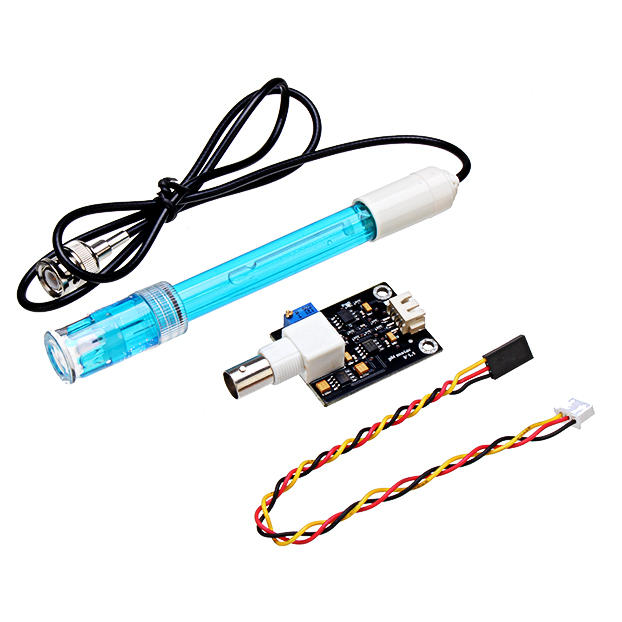Measuring pH sensors Values with Digital Sensors
 |
| pH Sensors |
What are pH Sensors?
In the scientific field, it is important to understand acidity levels of
liquids and solutions. Traditionally, acidic levels were measured using litmus
paper or pH indicators which provided only a general qualitative reading.
However, with advancements in technology, digital probe or electrode now allow
for precise quantitative measurement of hydrogen ion concentration or pH
values. A probe or electrode is an analytical device that uses a sensitive
electrode to measure the concentration or activity of hydrogen ions (H+) in a
solution. It provides direct correlation between the measured voltage and pH
value.
Types of probe or electrode
There are two main types of probe or electrode - glass
electrode sensors and ion-selective field effect transistor (ISFET) sensors.
Glass electrode sensors are more commonly used and contain a standardized
pH-sensitive glass bulb at the tip attached to a reference electrode within an
internal electrolyte solution. The voltage difference between the glass and
reference electrodes corresponds to sample pH. ISFET sensors are made with an
ion-selective membrane deposited on a gate of a field-effect transistor. They
do not require internal electrolyte solution but are more prone to drift over
time.
Mechanism of Glass Electrode Sensors
Glass electrode Ph
Sensors work on the principal of electrochemical difference between the
pH-sensitive glass membrane and internal reference electrode. The glass
membrane is designed with a very thin layer that allows only H+ ions to pass
through. When placed in a test solution, H+ ions from the solution exchange
with H+ ions in the glass, establishing an electrochemical equilibrium. This
generates a potential difference relative to the internal reference electrode
that is proportional to sample pH. Digital meters convert this voltage reading
into corresponding pH value.
Factors Affecting Accuracy
For reliable pH measurement, factors like temperature, solution composition and
membrane integrity need to be controlled. Glass sensors require periodic
calibration using buffer solutions of known pH (e.g. pH 4.01, 7.00, 10.01) to
remain accurate. Drift over time occurs due to leaching or hydration of glass
membrane. Regular cleaning, storage in pH buffer and timely membrane
replacement enhances sensor lifetime. Industrial samples containing proteins,
oils or suspended solids can coat or foul the sensitive glass surface affecting
readings until cleaned.
Applications in Industry and Research
Digital pH sensors have widespread applications due to their precision, small
size and affordability. They are commonly used for quality control testing in
water treatment plants, food & beverage production, agriculture, chemical
processing, pharmaceutical manufacturing and biomedical research. Water samples
are routinely checked at various treatment stages to ensure optimal pH levels
for coagulation, corrosion control or disinfection. In aquaculture, pH
monitoring prevents stress to aquatic species from fluctuations. Other common
uses include soil analysis in hydroponics, microbial fermentation monitoring,
antacid drug formulation and environment/pollution studies. Industrial probe or
electrode have durable bodies to withstand harsh conditions while research
grade sensors provide high accuracy at microscopic scale.
Wireless and Portable pH Meters
Advancements continue with the introduction of battery-powered portable units
equipped with Bluetooth or WiFi connectivity. These wireless pH meters allow
for remote monitoring of multiple sensors simultaneously over long distances
via tablet/phone apps. Data can be logged, graphed and alarms set for abnormal
pH levels. Portable models are compact and equipped with internal or external
probes suitable for field or on-site testing without requiring external meters.
They are suitable for quick spot checks during facility rounds, water sampling
from remote locations and field research applications like agriculture,
forestry or environmental surveys where transportation of bulky equipment is
difficult.
Combination ISE Sensors
In addition to standalone pH sensors, combination sensors are also available
that simultaneously measure pH along with other important parameters like
oxidation-reduction potential (ORP), conductivity or dissolved oxygen
concentration. This provides analytical capability using a single
multiparameter probe, minimizing required equipment. ORP/ probe
or electrode help evaluate disinfection effectiveness of municipal water
treatment and determine suitability of swimming pools. Conductivity/pH probes
efficiently analyze industrial wastewater treatment. Such combination digital
probes streamline data collection for applications where concurrent pH and
supporting parameter monitoring is essential.
Future Directions
Ongoing refinements are made to probe or electrode technology towards higher accuracy,
precision and cost-effectiveness. Improvements include miniaturization for
microfluidic analysis, durable membrane coatings to minimize drift and
calibration needs, self-cleaning capabilities using integrated wipers and
integrated temperature compensation. Combining pH sensing with additional
functions like sample preparation, fluid handling and wireless data
transmission further enhances practical usability. Efforts are also directed at
developing optical, fiber-optic and biosensor alternatives as pH transducers to
avoid bulky electrodes, simplify calibration and enable remote sensing for
industrial automation. With advancing technologies, digital probe or electrode
will continue automating routine analytical measurements across diversified
industrial sectors.
Get more insights on PH Sensors

%20Treatment%20(1).jpg)

Comments
Post a Comment